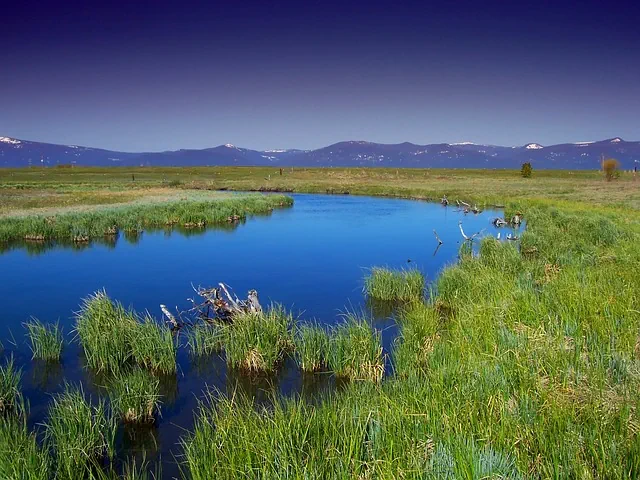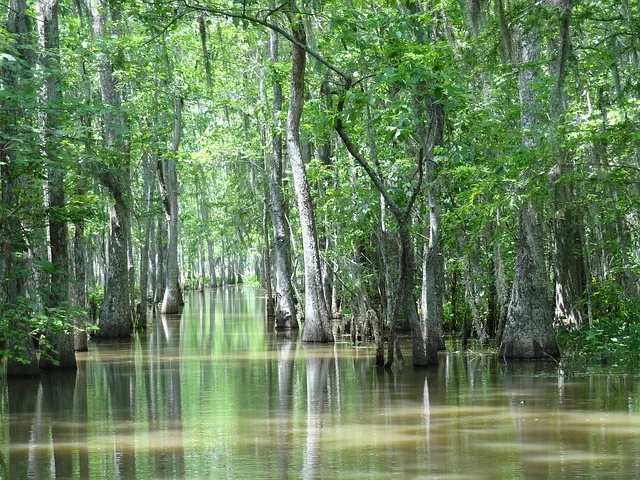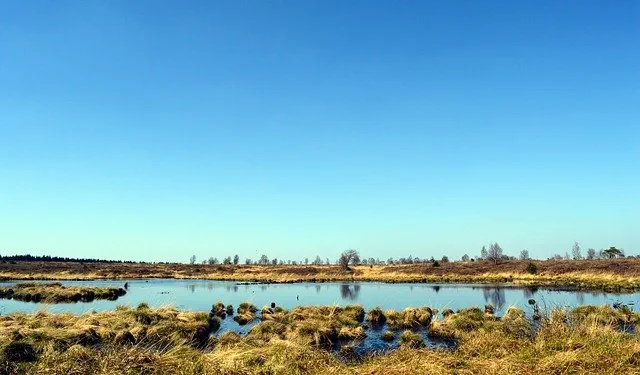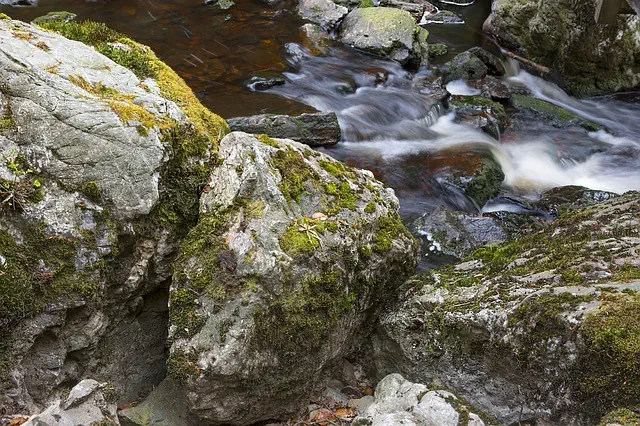
What are the 4 Types of Wetlands?

Table of Contents
Introduction
The United States is famous for its innumerable lakes like Superior, Huron, and Michigan. However, travel folders rarely mention all the four unique wetlands that dot vast portions of the land. What are the four types of wetlands? They are marshes, swamps, bogs, and fens. Unfortunately, some people use these terms interchangeably since they don’t know this. These wetlands have several unique characteristics that curious readers and environmentalists can’t afford to miss. Read on for more detailed information on the four types of wetlands and what sets them apart.

Great White Pelicans
Marshes
Marshes refer to wetlands that are continuously inundated. This means that the land in the affected area is always wholly submerged underwater. However, the amount of water in this wetland typically changes with seasons. Marshes boast of a wide assortment of vegetation that thrives in saturated soil. Besides, they have a neutral PH, plentiful nutrients, and abundant water supply that create a conducive environment for soft-stemmed vegetation to flourish.

Marsh
There are several categories of marshes. Some of these are the Prairie potholes, coastal, inland, Everglades, saltwater, and freshwater. They receive a significant amount of their water from surface water. Most of them also rely heavily on groundwater. Let’s now take a look at the two major categories of marshes.
Tidal Marshes
Tidal marshes are prevalent on the eastern coast of the United States and other protected coastline’s high and middle latitudes worldwide. So, you can come across the intertidal marsh and the high marsh.
Environmental Benefits
Tidal marshes serve the following functions:
- Buffer stormy seas and slow shoreline erosion
- Absorb excess nutrients before they reach rivers, lakes, oceans, etc.
- Provide essential food and habit for various sea animals
Non-Tidal
Non-tidal marshes are common in the United States and many other parts of the world. They typically occur along streams, particularly in poorly drained depressions.
These marshes also occur in shallow water along water bodies’ boundaries. Examples of non-tidal marshes are Wet Meadows, Playa Lakes, Prairie Potholes, and Vernal Pools.
Environmental Benefits
- Non-tidal marshes help the environment in the following ways:
- Sustain a wide array of plant communities
- Support a wide variety of wildlife
- Mitigate flood damage
- Filter excess nutrients from reaching lakes, rivers, etc
Swamps
What sets swamps apart from marshes? Woody plants, not soft-stemmed plants, dominate swamps. People harvest and use these resources to construct their homes and other structures. These wetlands are known to be one of the leading habitats for many birds, fish, and small creatures.

Swamp
Some swamps like the Everglades in Florida are found in low-lying areas near coastal areas or rivers. There are two main categories of swamps. These are:
Forested Swamps
You can find forested swamps in all parts of the United States. They are constantly inundated with water that originates from the nearby streams and rivers. In some cases, slowly moving or stagnant water covers these swamps by many feet. During the dry season, they may be the only source of water, which ensures the survival of various wetland-dependent species such as Cottonmouth Snakes, River Otters, and Wood Ducks.
The most common tree species in these areas are Red Maple, Pin Oak, Cypress, Willows, and Western Hemlock.
Shrub Swamps
Shrub swamps are the same as forested swamps in almost every way. They are always adjacent to one another. However, as the name suggests, shrubby vegetation like Swamp Rose, Dogwood, and Buttonbush dominate shrub swamps.
Shrub swamps are found in floodplains and along slow-moving streams. Mangrove swamps are a typical example of shrub swamps covering an extensive part of southern Florida.
Environmental Benefits
Forested and shrub swamps are beneficial to the environment in the following ways:
- Play a significant role in nutrient removal and food protection
- High in productivity
- Lowland swamps provide food for upland creatures
- Provide high-quality timber
Bogs
Bogs are perhaps among the least known wetlands despite their significant impact on the environment. Many people confuse them for other wetland types. These wetlands are more acidic and have lots of spongy peat deposits. Sphagnum moss covering also characterizes bogs.
Moreover, unlike swamps and marshes, bogs rely on precipitation rather than runoffs from rivers, groundwater, and streams. Due to this, they are deficient in nutrients. Suppose you add this to the fact that bog swamps are highly acidic. In that case, you discover why only plants and animals adapted to soggy conditions, low nutrient levels, and acidic waters like carnivorous plants thrive here.

Peat bog
Bogs form in two unique ways, as we shall see next.
-
Terrestrialization: Refers to the processes that allow sphagnum moss to grow over a waterbody and slowly fill it.
-
Paludification: In this case, sphagnum moss forms on dry land and hinders water from escaping the surface.
There are two leading types of wetlands, and they are:
Northern Bogs
These are the bogs that informed readers associate with short growing seasons and low temperatures. So, you can find many of them in the northern states where they form in old glacial lakes. The peats of these bogs cause excessive water to become highly acidic.
Pocosins
Pocosins are swamps characterized by evergreen trees and shrubs. They are prevalent in the coastal parts of Virginia, northern Florida, and North Carolina. Here, you won’t find stagnant water. Instead, you find a shallow water table that ensures the soil remains saturated almost throughout the year.
Pocosins are found in upland areas far away from streams. They are ombrotrophic. This means they largely depend on the rain like northern bogs. When these lands are dry during the summer or spring, natural fires sometimes occur and destroy large portions of the vegetation.
The most common plants in pocosins are Red Bay, Sweet Bay, Loblolly, and other evergreen trees.
Others are evergreen shrubs like Zenobia and titi.
Environmental Benefits
Here are some of the ways bogs protect the environment:
- Absorb precipitation
- Prevent downstream flooding
- Support carnivorous Sundew and other plants with particular feeding habits in the US and worldwide
- Provide habitat for endangered species
Fens
Now that you understand bogs, you’ll find it easy to know what fens means and how it impacts the environment. The only vital difference to note down is that fens get their wetness from groundwater. This means they are slightly less acidic and can help support a wide variety of wildlife and plants.
Parallel vegetation ridges that productive hollows separate characterize some fens. These ridges often form perpendicular to the downslope. This can allow peat to build up and disconnect the wetland from its water supply over time. If this happens, the nutrient supply can reduce, causing the wetland to turn into a bog. Please note that fens occur in the northern hemisphere like bogs. They are highly prevalent in the northeastern United States, the Rocky Mountains, and the Great Lakes regions.

Fens
Environmental Benefits
Fens protect the environment in the following ways:
- Prevent or reduce floods
- Improve water quality
- Provide habitat for a wide variety of plants and animals
Are the 4 Types of Wetlands Threatened Resources?
Wetlands are threatened resources, and that might hurt the Earth. We’ve answered the question, what are the four types of wetlands?
Now let’s see what threatens wetlands. Destruction of wetlands is currently happening in all parts of the world. Even though the United States has enacted several laws to preserve the resource, we still need to do more. Ecologists, naturalists, environmentalists, and responsible people remain concerned today because some people regard bogs and other wetlands as prime dumping sites.
Moreover, others clear the wetlands for agricultural and development resources. Some use the shrubs and trees as firewood. Careless individuals also dredge ponds, leaving birds that require shallow water struggling to find alternative habitats.
At the same time, the frequent filling in or draining of wetlands can permanently destroy entire communities of wildlife and plants. What about building a highway through any of the coastal marshes? It can damage forests, which are natural carbon sinks.
Water and air pollution also threaten the existence of these resources. Excessive use of weed killers and insecticides can take a heavy toll on wildlife and plants. Industrial wastes can have the same adverse impact on various ecosystems.
Overall, the disruption that humans cause threatens the existence of wetlands. By extension, the interference destroys the natural habit of some wildlife.
What Can We Do to Protect Wetlands?
This article, “What are the four types of wetlands”, has most likely helped you to see clearly how much our environment depends on wetlands. You can also tell what human disruption means to the future of the Earth. If we ignore the danger signs, we might not have timber after a short while due to the increased pollution of lakes, oceans, rivers, and others. The plant and animal communities that call wetlands home may soon disappear from the face of the Earth and cause uncertainties regarding the future of the human race.
So, what should we do? Our first step should be to get rid of the false assumption that wetlands are wastelands. This calls for changing our attitudes and helping others to do the same. Besides, we should support the initiatives of our governments, conservation groups, and other teams and agencies geared towards saving these essential resources. The Earth’s future significantly depends on what you and other like-minded people do today to save the four types of wetlands.